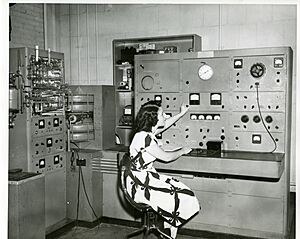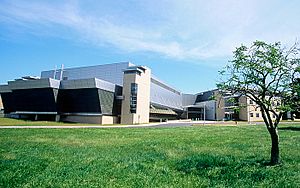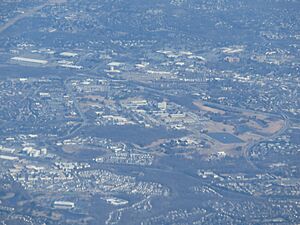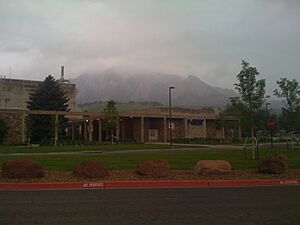National Institute of Standards and Technology facts for kids
 |
|
| Agency overview | |
|---|---|
| Formed |
|
| Headquarters | 100 Bureau Drive Gaithersburg, Maryland, U.S. 39°07′59″N 77°13′25″W / 39.13306°N 77.22361°W |
| Employees | Approx. 3,400 |
| Annual budget | $1.03 billion (FY 2021) |
| Agency executive |
|
| Parent department | Department of Commerce |
The National Institute of Standards and Technology (NIST) is an agency of the United States Department of Commerce. Its main job is to help American businesses and inventors create new things and compete well. NIST works on many science programs. These include nanoscale science, engineering, information technology, and measuring materials and physical things. Before 1988, the agency was called the National Bureau of Standards.
Contents
A Brief History of NIST
Why Standards Are Important
Long ago, the United States government realized how important it was to have fair and consistent ways to measure things. The first rules for the U.S. government, called the Articles of Confederation, said that Congress should set standards for weights and measures.
Later, the Constitution of the United States also gave Congress this power. In 1790, President George Washington said that having the same money, weights, and measures was very important. He asked Congress to work on this many times.
Even with these requests, it took a while for the U.S. to get a single set of standards. From 1830 until 1901, a small office within the Department of the Treasury handled weights and measures.
The Bureau of Standards: 1901-1988
In 1901, the Bureau of Standards was created. Its job was to provide standard weights and measures for the country. It also became the national science lab for the U.S.
President Theodore Roosevelt chose Samuel Wesley Stratton to be the first director. The Bureau started with a small budget. It took care of the official copies of the kilogram and meter bars, which were the main standards for U.S. measurements. They also began offering services to help scientists and businesses measure things accurately.
The Bureau built a lab in Washington, D.C.. They bought special tools from other countries' labs. Besides weights and measures, they also worked on tools for measuring electricity and light. In 1905, they held the first "National Conference on Weights and Measures."
Over time, the Bureau did more than just measure. It helped create standards for many products. These included clothing, car parts like brakes and headlights, and electrical safety. During World War I, the Bureau helped with war production. They even made their own optical glass when supplies from Europe stopped.
Between the World Wars, a scientist named Harry Diamond developed a radio system to help planes land safely in bad weather. During World War II, the Bureau did military research. This included predicting how radio signals would travel and developing new weapons.

In 1948, the Bureau started building a computer called SEAC (Standards Eastern Automatic Computer). It began working in 1950. Another computer, SWAC, was built in Los Angeles.
NIST: From 1988 to Today
Because its work changed and grew, the "National Bureau of Standards" became the "National Institute of Standards and Technology" in 1988.
After the September 11, 2001 attacks, NIST led the official investigation into why the collapse of the World Trade Center buildings fell. More recently, after the 2021 Surfside condominium building collapse, NIST engineers also investigated what caused that building to collapse.
In 2019, NIST started a project called "NIST on a Chip." This project aims to shrink large lab instruments down to the size of a computer chip. This could help with things like testing aircraft and communicating with satellites.
In 2023, the U.S. government planned to create a U.S. AI Safety Institute within NIST. This institute would help manage AI safety issues.
How NIST Works
NIST is a measurement standards laboratory. It is a non-regulatory agency, meaning it doesn't make laws, but it helps set the technical basis for them. NIST's main goal is to:
Promote U.S. innovation and industrial competitiveness by advancing measurement science, standards, and technology in ways that enhance economic security and improve our quality of life.
NIST has about 2,900 scientists, engineers, and staff. About 1,800 guest researchers from companies and other countries also work there. NIST also partners with many manufacturing experts across the country.
The Metric System and NIST
In 1866, the U.S. Congress made it legal to use the metric system for business. In 1875, many countries signed the Treaty of the Meter. This agreement created the International Bureau of Weights and Measures. This international group helps keep measurements the same around the world.
NIST Locations and Labs
NIST has its main office in Gaithersburg, Maryland. It also has a facility in Boulder, Colorado, which opened in 1954. NIST's work is divided into different laboratory programs. Since 2010, NIST has six main labs:
- Communications Technology Laboratory (CTL)
- Engineering Laboratory (EL)
- Information Technology Laboratory (ITL)
- Center for Neutron Research (NCNR)
- Material Measurement Laboratory (MML)
- Physical Measurement Laboratory (PML)
NIST also has programs that work with outside groups:
- Hollings Manufacturing Extension Partnership (MEP): This helps small and medium-sized manufacturers improve their work and grow.
- Technology Innovation Program (TIP): This program gives grants to help develop new, risky technologies.
- Baldrige Performance Excellence Program: This program gives out the Malcolm Baldrige National Quality Award. This is the highest award in the U.S. for business excellence.
NIST-F1: The Atomic Clock
NIST's Boulder labs are famous for NIST‑F1. This is an atomic clock that serves as the source of the nation's official time. NIST-F1 measures the natural vibration of cesium atoms. This vibration defines what a second is. NIST then broadcasts time signals using radio stations like WWVB and WWV.
Neutron Research and Nanotechnology
NIST also has a special facility called the NIST Center for Neutron Research (NCNR). Scientists use this facility to study materials using neutron scattering. This helps them research many areas, like fuel cells and biotechnology.
The Center for Nanoscale Science and Technology (CNST) studies nanotechnology. They have a special cleanroom facility called "NanoFab." This lab has tools for making tiny patterns and imaging very small things.
Important Projects and Standards
Measurements and Reference Materials
NIST provides over 1,300 special items called Standard Reference Materials (SRMs). These are certified to have exact features or contents. They are used to check measuring equipment, control quality in factories, and as samples in experiments.
Handbook 44
NIST publishes the Handbook 44 every year. This book provides rules and requirements for weighing and measuring devices. It helps make sure that scales and other measuring tools are accurate across the country. NIST has been publishing versions of this handbook since 1918.
Cybersecurity Framework
In February 2014, NIST released the NIST Cybersecurity Framework. This guide helps organizations manage and reduce risks related to cybersecurity. It was updated in April 2018. This framework is now required for U.S. federal government agencies.
The framework also highlights the importance of Zero-trust architecture (ZTA). This idea means "never trust, always verify." It helps protect computer systems by checking every user and device, even if they are already inside the network. This makes it harder for unauthorized people to get access.
NIST released a new draft of the framework, CSF 2.0, in 2023. This update aims to make it easier for smaller businesses to use. In August 2024, NIST released new encryption tools. These tools are designed to protect electronic information from powerful quantum computers.
Moonlight Calibration Initiative
In May 2025, NIST announced the Moonlight data project. This project aims to improve how satellites are calibrated. By measuring the Moon's brightness very precisely, NIST helps make Earth observation satellites more accurate. This helps with things like agriculture, weather forecasting, and watching the environment.
Notable People at NIST
Four scientists who worked at NIST have won Nobel Prizes in physics. These include William Daniel Phillips (1997), Eric Allin Cornell (2001), John Lewis Hall (2005), and David Jeffrey Wineland (2012). Their work on laser cooling atoms helped develop and improve the atomic clock.
In 2011, Dan Shechtman won the Nobel Prize in chemistry for his work on quasicrystals at NIST. Many other important scientists have also worked at NIST.
- Milton Abramowitz
- James Sacra Albus
- David W. Allan
- Kathryn Beers
- Norman Bekkedahl
- Julie Borchers
- Ferdinand Graft Brickwedde
- Lyman James Briggs
- Edgar Buckingham
- John M. Butler
- William Weber Coblentz
- Ronald Collé
- Philip J. Davis
- Marla Dowell
- Hugh Latimer Dryden
- Jack R. Edmonds
- Ugo Fano
- Charlotte Froese Fischer
- Tim Foecke
- John Cantius Garand
- Katharine Blodgett Gebbie
- Nada Golmie
- Douglas Rayner Hartree
- Magnus Rudolph Hestenes
- Marcia Huber
- Marilyn E. Jacox
- Deborah S. Jin
- John Kelsey
- Russell A. Kirsch
- Cornelius Lanczos
- Wilfrid Basil Mann
- William Clyde Martin
- John M. Martinis
- Willie E. May
- Alexander Maranghides
- William Frederick Meggers
- Christopher Roy Monroe
- James G. Nell
- Perley G. Nutting
- Frank William John Olver
- Anne Plant
- E. Ward Plummer
- Jacob Rabinow
- Ana Maria Rey
- Richard J. Saykally
- Charlotte Emma Moore Sitterly
- Irene Ann Stegun
- William C. Stone
- Elham Tabassi
- Sheldon M. Wiederhorn
- Winnie Wong-Ng
- Helen M. Wood
- Ellen Voorhees
NIST Directors
Since 1989, the President chooses the director of NIST, and the United States Senate must approve the choice. The director also holds the title of Under Secretary of Commerce for Standards and Technology.
Patents Held by NIST
NIST holds patents for the Federal government of the United States. Some of these patents are held to protect public use. For example, NIST holds a patent for a Chip-scale atomic clock. This tiny clock was developed by a NIST team.
See also
 In Spanish: Instituto Nacional de Estándares y Tecnología para niños
In Spanish: Instituto Nacional de Estándares y Tecnología para niños
- Dimensional metrology
- Forensic metrology
- Quantum metrology
- Smart Metrology
- Time metrology
- Advanced Encryption Standard process
- Digital Library of Mathematical Functions (DLMF)
- Facial age estimation
- International Organization for Standardization (ISO)
- ISO/IEC 17025 – used by testing and calibration laboratories
- International System of Units, see International Bureau of Weights and Measures
- National Physical Laboratory (United Kingdom)
- National Software Reference Library
- NIST Handbook of Mathematical Functions
- NIST hash function competition
- Samuel Wesley Stratton Award
- Smart Grid Interoperability Panel
- Technical Report Archive & Image Library for NIS-digitized series
- WWV (radio station)
- Virtual Cybernetic Building Testbed





